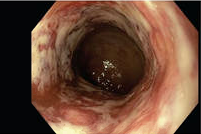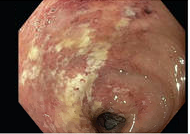Monday Poster Session
Category: GI Bleeding
P3153 - Spontaneous Ischemic Proctitis in an Elderly Male on Anticoagulation
Monday, October 27, 2025
10:30 AM - 4:00 PM PDT
Location: Exhibit Hall
- DW
Daniel Weber, DO (he/him/his)
Madigan Army Medical Center
Tacoma, WA
Presenting Author(s)
Daniel Weber, DO, Cesar Rosa, DO
Madigan Army Medical Center, Tacoma, WA
Introduction: The rectum is typically spared from ischemic injury due to its rich dual blood supply from the superior (inferior mesenteric artery), middle (internal iliac), and inferior (internal pudendal) rectal arteries. However, in rare cases–especially in elderly, debilitated patients with vascular disease–ischemic proctitis can occur. We presented a rare case of spontaneous ischemic proctitis in a 95-year-old male on therapeutic anticoagulation.
Case Description/
Methods: A 95-year-old male with severe aortic stenosis (deferred AVR), CKD stage II, advanced dementia, and recent left lower extremity DVT recently started on apixaban 9 days earlier who presented after a witnessed large-volume melanic stool. His presenting hemoglobin was 4.5 g/dL (baseline 10.3 g/dL), though was initially hemodynamically stable. Exam revealed melena and rectal pain on DRE. BUN was 42 from prior baseline of 20. CTA abdomen and pelvis was unremarkable for acute process but revealed extensive vascular atherosclerosis throughout. In the emergency department he received pRBCs, IV pantoprazole, and Kcentra. He was admitted for the ICU for resuscitation, and endoscopic evaluation. His EGD was unremarkable however ileo-colonoscopy revealed hematin in the descending and sigmoid colon with a large rectal clot obscuring approximately 50% of the mucosa, resistant to irrigation. After multiple Fleet enemas, subsequent bedside flexible sigmoidoscopy revealed a friable, erythematous, ulcerated mucosa with stigmata of recent bleeding and a "single stripe sign" in the rectum. Hemostatic spray was applied, and biopsies were obtained.
Histology results confirmed ischemic proctitis: Epithelial atrophy, necrosis, and hemorrhage. Sigmoid biopsies were normal. No infectious organisms were identified. Mesalamine suppositories were initiated. Despite stabilization, his course was complicated by worsening functional and nutritional decline. Given his advanced dementia and prior directives, care was transitioned to comfort-focused measures.
Discussion: Ischemic proctitis is a rare diagnosis due to extensive rectal vascular collateralization. This case illustrates how vascular disease, hypoperfusion, and anticoagulation can predispose, particularly elderly patients, to rectal ischemia. Diagnosis requires endoscopy and biopsy for confirmation. Management primarily includes supportive care, hemostasis, and withdrawal of inciting agents with additional mesalamine for potentially symptomatic relief.

Figure: Flexible sigmoidoscopy, at the level of the proximal rectum, showing a characteristic "single stripe sign" of ulceration and friability classically seen in ischemic colitis.

Figure: Flexible sigmoidoscopy, at the level of the distal rectum, showing worsening ulceration and friability which encompasses the entire mucosa circumferentially.
Disclosures:
Daniel Weber indicated no relevant financial relationships.
Cesar Rosa indicated no relevant financial relationships.
Daniel Weber, DO, Cesar Rosa, DO. P3153 - Spontaneous Ischemic Proctitis in an Elderly Male on Anticoagulation, ACG 2025 Annual Scientific Meeting Abstracts. Phoenix, AZ: American College of Gastroenterology.
Madigan Army Medical Center, Tacoma, WA
Introduction: The rectum is typically spared from ischemic injury due to its rich dual blood supply from the superior (inferior mesenteric artery), middle (internal iliac), and inferior (internal pudendal) rectal arteries. However, in rare cases–especially in elderly, debilitated patients with vascular disease–ischemic proctitis can occur. We presented a rare case of spontaneous ischemic proctitis in a 95-year-old male on therapeutic anticoagulation.
Case Description/
Methods: A 95-year-old male with severe aortic stenosis (deferred AVR), CKD stage II, advanced dementia, and recent left lower extremity DVT recently started on apixaban 9 days earlier who presented after a witnessed large-volume melanic stool. His presenting hemoglobin was 4.5 g/dL (baseline 10.3 g/dL), though was initially hemodynamically stable. Exam revealed melena and rectal pain on DRE. BUN was 42 from prior baseline of 20. CTA abdomen and pelvis was unremarkable for acute process but revealed extensive vascular atherosclerosis throughout. In the emergency department he received pRBCs, IV pantoprazole, and Kcentra. He was admitted for the ICU for resuscitation, and endoscopic evaluation. His EGD was unremarkable however ileo-colonoscopy revealed hematin in the descending and sigmoid colon with a large rectal clot obscuring approximately 50% of the mucosa, resistant to irrigation. After multiple Fleet enemas, subsequent bedside flexible sigmoidoscopy revealed a friable, erythematous, ulcerated mucosa with stigmata of recent bleeding and a "single stripe sign" in the rectum. Hemostatic spray was applied, and biopsies were obtained.
Histology results confirmed ischemic proctitis: Epithelial atrophy, necrosis, and hemorrhage. Sigmoid biopsies were normal. No infectious organisms were identified. Mesalamine suppositories were initiated. Despite stabilization, his course was complicated by worsening functional and nutritional decline. Given his advanced dementia and prior directives, care was transitioned to comfort-focused measures.
Discussion: Ischemic proctitis is a rare diagnosis due to extensive rectal vascular collateralization. This case illustrates how vascular disease, hypoperfusion, and anticoagulation can predispose, particularly elderly patients, to rectal ischemia. Diagnosis requires endoscopy and biopsy for confirmation. Management primarily includes supportive care, hemostasis, and withdrawal of inciting agents with additional mesalamine for potentially symptomatic relief.

Figure: Flexible sigmoidoscopy, at the level of the proximal rectum, showing a characteristic "single stripe sign" of ulceration and friability classically seen in ischemic colitis.

Figure: Flexible sigmoidoscopy, at the level of the distal rectum, showing worsening ulceration and friability which encompasses the entire mucosa circumferentially.
Disclosures:
Daniel Weber indicated no relevant financial relationships.
Cesar Rosa indicated no relevant financial relationships.
Daniel Weber, DO, Cesar Rosa, DO. P3153 - Spontaneous Ischemic Proctitis in an Elderly Male on Anticoagulation, ACG 2025 Annual Scientific Meeting Abstracts. Phoenix, AZ: American College of Gastroenterology.
